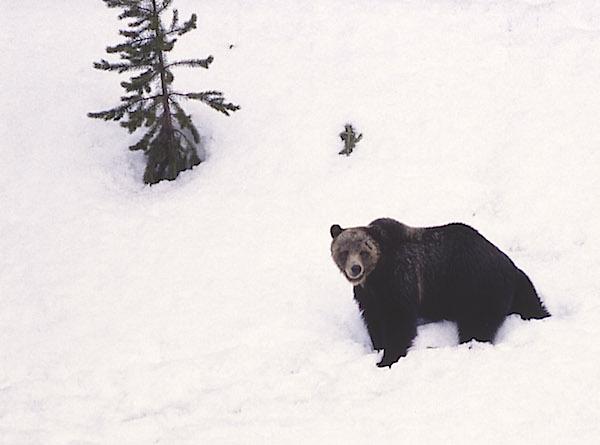
It's early, but grizzlies are starting to emerge from their dens in Yellowstone National Park. This shot is a file photo, taken in April 1997, by Jim Peaco of the park staff.
Here it is, not even mid-February, and grizzly bears are starting to emerge from their dens at Yellowstone National Park.
Park biologists are suggesting that the relatively mild winter weather is behind the early awakening of grizzlies in the greater Yellowstone area. The first confirmed report of grizzly bear activity in Yellowstone occurred this past Monday, when a bear was observed late in the afternoon, scavenging on a bison carcass in the central portion of the park.
With bears emerging from hibernation hikers, skiers, and snowshoers are advised to stay in groups of three of more, make noise on the trail and carry bear spray. The same advice goes for those taking guided snowmobile trips in Yellowstone.
Bears begin looking for food soon after they emerge from their dens. They are attracted to elk and bison that have died during the winter. Carcasses are an important enough food source that bears will sometimes react aggressively when surprised while feeding on them.
Updated bear safety information is available on the Yellowstone bear safety Web page and in the park newspaper distributed at all park entrances.
Yellowstone regulations require visitors to stay 100 yards from black and grizzly bears at all times. The best defense is to stay a safe distance from bears and use binoculars, a spotting scope, or telephoto lens to get a closer look. All visitors traveling in the park away from developed areas should stay in groups of three or more, make noise on the trail, keep an eye out for bears and carry bear spray. Bear spray has proven to be a good last line of defense, if kept handy and used according to directions when a bear is approaching within 30 to 60 feet.
While firearms are allowed in the park, the discharge of a firearm is a violation of park regulations. The park's law enforcement rangers who carry firearms on duty rely on bear spray, rather than their weapons, as the most effective means to deal with a bear encounter.
Visitors are also reminded to keep food, garbage, barbecue grills and other attractants stored in hard-sided vehicles or bear-proof food storage boxes. This helps keep bears from becoming conditioned to human foods, and helps keep park visitors and their property safe.
Bear sightings should be reported to the nearest visitor center or ranger station as soon as possible.



Add comment